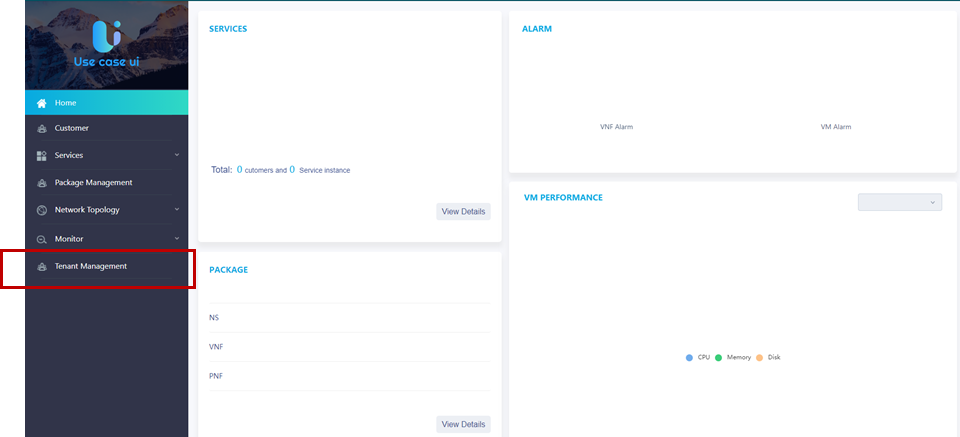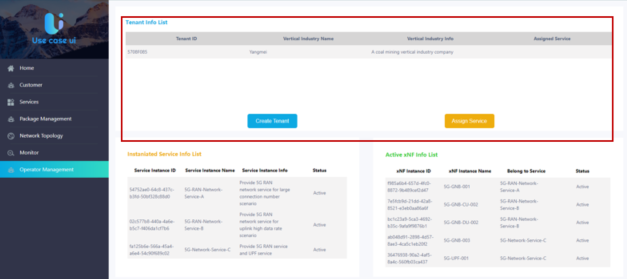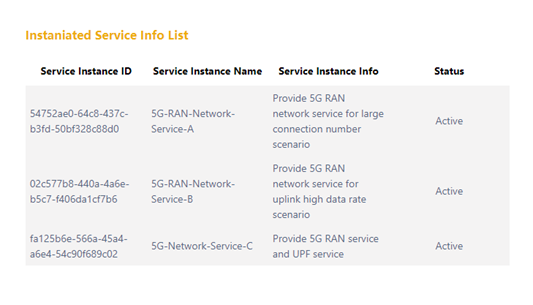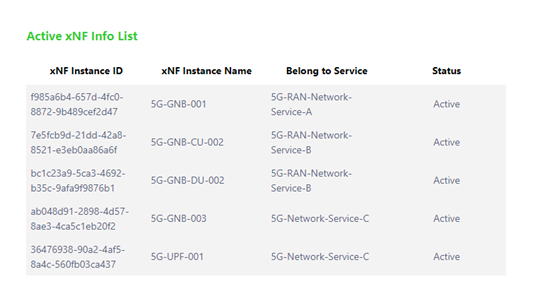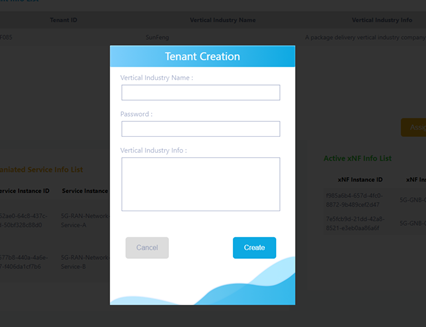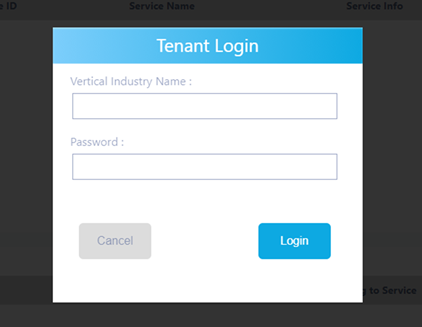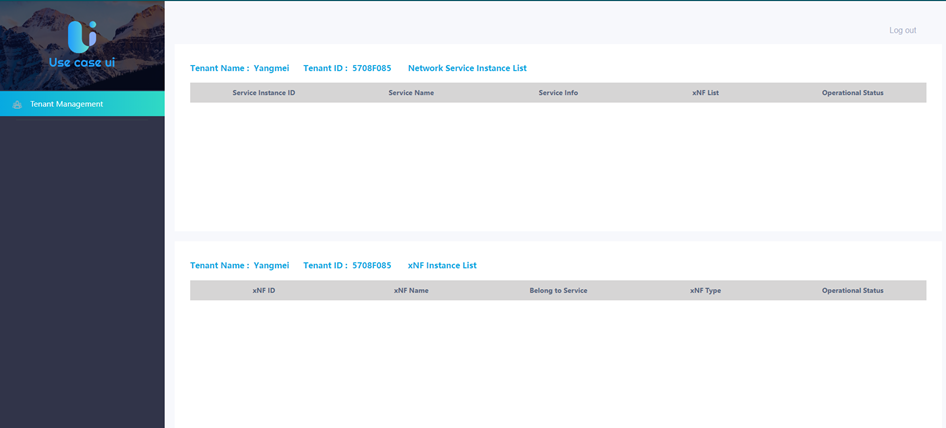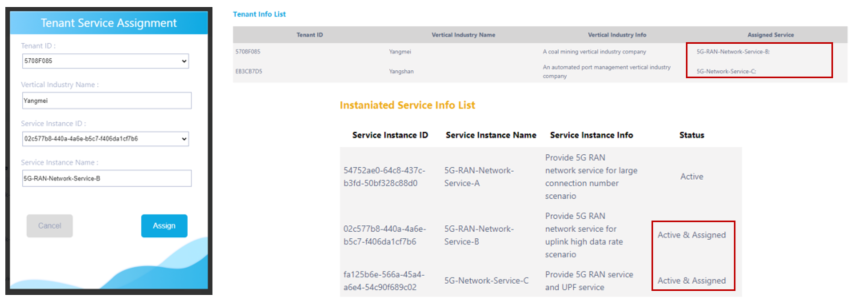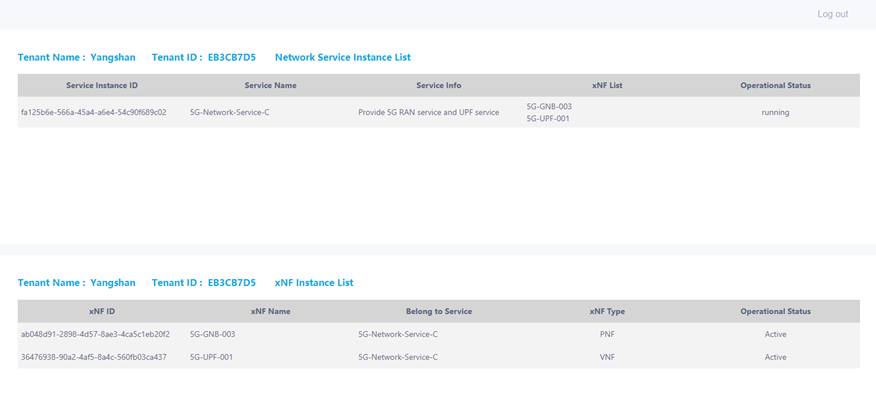Vertical Industry Use Case
Use Case Overview & Description
Note: 'Support for Vertical Industry' might be viewed as Honolulu POC (TSC 2020-11-05 ).
Vertical Industry is one of the greatest potential 5G markets. Unlike traditional 2C scenarios, where the consumers of OSS are CSP internal operation staff or BSS system, in 5G era operators need to provide O&M capabilities for potentially multiple vertical industries consumers. This requirement propose to help operators to manage multiple vertical industry networks using ONAP.
It will contain the following scenarios:
a) One centralized operator ONAP only manages multiple vertical industry networks established by operators, and
b) One centralized operator ONAP manages both vertical industry networks and traditional mobile networks (e.g. slicing).
Requirement Summay
- Tenant management and isolation for Vertical Industry
- Enhance A&AI Schema for vertical industry tenant, including basic tenant profile
- Isolate resources (pnf/vnf/service instance etc.) from different vertical industry tenants, and shares potential resources between operator network and vertical industry network
- Implement permission control for different vertical industry tenants by leveraging Multi-tenancy in ONAP.
- Provide centralized user interface in UUI for different vertical industry tenants, allowing them to access their own data, including resources and necessary configurations.
- Enhance service instantiation procedure with specified tenant and necessary vertical industry area (aka. specified locations)
- Adding necessary building blocks or workflows for service instantiation in ONAP SO.
- Support for vertical industry scenario A in R8
- Operator instantiates different services for two different vertical tenants, further creates initial NRM configurations for them.
- Tenants are expected to access their own resources from centralized UUI.
Use Case Key Information
| TOPIC | DESCRIPTION | WIKI PAGE |
| Requirements Proposal | This is a link to the requirements proposal made on the Requirements Sub-committee。 | REQ-468 - Getting issue details... STATUS |
| Architecture S/C info | Information on the Architecture sub-committee presentation | 2020-11-24: Honolulu-R8 PoC Requirements Architecture Reviews |
| Prior Project "Base" Wiki | Link to the "base" wiki for the Use Case, or work from a prior release. | |
| Requirements Jira (REQ-###) Ticket | Link to the REQ Jira ticket for this use case | REQ-468 - Getting issue details... STATUS |
| Key Use Case Leads & Contacts | USE CASE LEAD: Lei Huang Zhang Min Cheng Huang yaoguang wang USE KEY CONTACTS: | |
| Meetings Register & Recordings | Link to Use Case Team meetings. | 2021-01-14: Use Case Realization Meeting Register MoM |
BUSINESS DRIVER
This section describes Business Drivers needs. These business drivers are presented on the Requirements Sub-committee and should also be put into the release requirements sub-committee page.
Executive Summary - Vertical Industry is one of the greatest potential 5G markets. Unlike traditional 2C scenarios, where the consumers of OSS are CSP internal operation staff or BSS system, in 5G era operators need to provide O&M capabilities for potentially multiple vertical industries consumers. This requirement propose to help operators to manage multiple vertical industry networks using ONAP. In R8, it will contain the following scenarios: a) One centralized operator ONAP only manages multiple vertical industry networks established by operators, and b) One centralized operator ONAP manages both vertical industry networks and traditional mobile networks (e.g. slicing).
Business Impact - Vertical industry networks contain various combinations of resources, such as VNFs, PNFs, and service instances. Providing one unified OM platform is the most efficient way to satisfy various vertical industry’s requirements. ONAP can be a great automation management platform for 5G vertical industry.
Business Markets - All operators and service providers that want to use ONAP to support the management of vertical industry networks
Funding/Financial Impacts - Reduce the operation expense while providing Network O&M service for different vertical industries.
Organization Mgmt, Sales Strategies - (It is suggested that you use the following wording): There is no additional organizational management or sales strategies for this use case outside of a service providers "normal" ONAP deployment and its attendant organizational resources from a service provider. (This would typically describe the "WHO", but because use cases are all deployed with ONAP itself, these two areas come with the actual ONAP deployment and uses the organizational management and sales strategies of a particular service provider's ONAP deployment)
Development Status
| PROJECT | PTL | User Story / Epic | Requirement |
| A&AI | |||
| AAF | |||
| APPC | |||
| CLAMP | |||
| CC-SDK | |||
| DCAE | |||
| DMaaP | |||
| External API | |||
| HOLMES | |||
| MODELING | |||
Multi-VIM / Cloud | |||
| OOF | |||
| OOM | |||
| POLICY | |||
| PORTAL | |||
| SDN-C | |||
| SDC | |||
| SO | |||
| VID | |||
| VF-C | |||
| VNFRQTS | |||
| VNF-SDK | |||
| CDS |
List of PTLs:Approved Projects
*Each Requirement should be tracked by its own User Story in JIRA
Report
Support for vertical industry scenario A in R8
Enhance UUI:
- Deign and develop tenant management portal in ONAP UUI. Through this portal, operator can create the tenant account for vertical industry tenant and assign the instantiated service instance to the corresponding;
- Design and develop separate management portal for vertical industry outside ONAP UUI. Through this portal, vertical industry can query the info which they are allowed to access.
Develop the external database to store the tenant info and the info about relation between vertical industry tenant and instantiated service instance and xNF instance. In the future release, the external database may be merged with AAI or CPS:
- Now, AAI is used to save the info about instantiated service instances and corresponding xNF instances;
- Now, CPS is used to save the network configuration info.
Enhance SO:
- ONAP UUI will trigger the PNF instantiation process based on the tenant info.
PoC Demo in R8
Pre-conditions:
- Design and publish Service/PNF/Workflow for vertical industry tenants.
- Design and publish corresponding CDS Blueprint.
- Instantiate corresponding network service instance.
Steps:
- Operator access the tenant management portal inside ONAP UUI to create tenant account for vertical industries. This portal can only be accessed by operator. The vertical industry tenant account info will be saved in the external database. The external database can be merged with A&AI or CPS in the future.
- Vertical industry tenant account login the separate management portal outside ONAP UUI. This portal can only be accessed by vertical industry. Query the external database to verify the password.
- 3. Vertical industry tenant account query the info about assigned network service (none) through the separate management portal outside ONAP UUI.
- 4. Operator access the tenant management portal inside ONAP UUI to assign the instantiated network service instances to the corresponding vertical industry tenant account. The assign-relation between vertical industry tenant account and service instance will be saved in the external database. The external database can be merged with A&AI or CPS in the
- Each Vertical industry tenant account login the separate management portal outside ONAP UUI to query the info about assigned network service instances and xNF instances.
In Support For Vertical Industry PoC, we design and develop Tenant Management Portal for operator inside ONAP Use Case UI:
- Tenant Management Portal: Only operator maintenance officers can access. Through this portal, operator maintenance officers can create a Tenant account for the corresponding vertical Industry, assign the instantiated network service to the corresponding vertical industry tenant and monitor the info about the existing vertical industry tenant accounts, instantiated network services, and active xNFs;
The list in the red block is used to present the info about existing vertical industry tenant. Each row contains info about tenant ID (unique), vertical industry name, vertical industry info (human readable) and assigned service (service instance name) :
- Create Tenant: Press this button. The operator maintenance officers can create one tenant account for the corresponding vertical industry;
- Assign Service: Press this button. The operator maintenance officers can assign the instantiated service to the corresponding vertical industry tenant account.
Use case UUI query A&AI for the info about assigned network instance and active xNF:
The list with yellow title is used to present info about instantiated network service instance. Three instantiated network service instances:
- 5G-RAN-Network-Service-A: Provide 5G RAN network service for large connection number scenario;
- 5G-RAN-Network-Service-B: Provide 5G RAN network service for uplink high data rate scenario;
- 5G-RAN-Network-Service-B: Provide 5G RAN service and UPF service.
The list with green title is used to present info about active xNF instance. Two active xNF instances:
- PNF: 5G-GNB-001 belongs to 5G-RAN-Network-Service-A;
- PNF: 5G-GNB-CU-002 belongs to 5G-RAN-Network-Service-B;
- PNF: 5G-GNB-DU-002 belongs to 5G-RAN-Network-Service-B;
- PNF: 5G-GNB-003 belongs to 5G-RAN-Network-Service-C;
- VNF: 5G-UPF-001 belongs to 5G-RAN-Network-Service-C.
In Support For Vertical Industry PoC, we design and develop separate Management portal outside ONAP UUI for vertical industry tenant:
- Separate Management Portal: Only vertical industry maintenance officers can access. In this page, the vertical industry maintenance officer can monitor info about the network service instances and xNFswhich have been assigned to this vertical industry tenant.
Step 1. Operator maintenance officers create one tenant account for corresponding vertical industry:
- Vertical Industry Name: Yangmei
- Password: 123456
- Vertical Industry info: A coal mining vertical industry company
The Use case UUI save the Vertical Industry Tenant info in the external database for now. The external database can be merged with CPS in the future.
Step 2. Vertical Industry maintenance officers access the Tenant Management Page and trigger the Tenant Login Function:
- Vertical Industry Name: Yangmei
- Password: 123456
The Use case UUI query the external database for vertical industry tenant info to verify the password.
Step 3. Vertical Industry (Yangmei) maintenance officers access the Tenant Management Portal. Tenant Management Portal will present the info about network service instances and xNF instances which has been assigned to the Vertical Industry (Yangmei) Tenant. Now no network service instance and xNF instance has been assigned to Vertical Industry (Yangmei) .
The Use case UUI will first query the external database for the relation (assigned-relation) between vertical industry (Yangmei) tenant and the instantiated network service instance and active xNF instance. Now no instantiated network service instance and active xNF instance have been assigned to Vertical Industry (Yangmei) Tenant. The Use case UUI doesn’t need to query AAI for assigned network service instance and xNF instance.
Step 4. The operator maintenance officers press the yellow “Assign Service” button to assign the instantiated service to the corresponding vertical industry tenant account:
- 5G-RAN-Network-Service-B à Vertical Industry Yangmei
- 5G-RAN-Network-Service-C à Vertical Industry Yangshan
The Use case UUI will save the relation (assigned-relation) between vertical industry tenant and the instantiated network service instance and active xNF instance in the external database.
Step 5. Vertical Industry (Yangmei) maintenance officers access the Separate Management Portal. The Separate Management Portal will present the info about network service instances and xNF instances which has been assigned to the Vertical Industry (Yangmei) Tenant. Now one network service instance (5G-RAN-Network-Service-B) has been assigned to Vertical Industry (Yangmei). And the xNF instances (5G-GNB-CU-002 and 5G-GNB-DU-002) which belongs to the network service instance (5G-RAN-Network-Service-B) has also been assigned to Vertical Industry (Yangmei) .
The Use case UUI will first query the external database for the relation (assigned-relation) between vertical industry (Yangmei) tenant and the instantiated network service instance and active xNF instance. Now one instantiated network service instance and active xNF instance have been assigned to Vertical Industry (Yangmei) Tenant. The Use case UUI will then query AAI for the detailed info about 5G-RAN-Network-Service-B, 5G-GNB-CU-002 and 5G-GNB-DU-002.
Step 6. Vertical Industry (Yangshan) maintenance officers access the Separate Management Portal. The Separate Management Portalwill present the info about network service instances and xNF instances which has been assigned to the Vertical Industry (Yangshan) Tenant. Now one network service instance (5G-Network-Service-C) has been assigned to Vertical Industry (Yangshan). And the xNF instance (5G-GNB-003 and 5G-UPF-001) which belongs to the network service instance (5G-Network-Service-C) has also been assigned to Vertical Industry (Yangshan) .
The Use case UUI will first query the external database for the relation (assigned-relation) between vertical industry (Yangshan) tenant and the instantiated network service instance and active xNF instance. Now one instantiated network service instance and active xNF instance have been assigned to Vertical Industry (Yangshan) Tenant. The Use case UUI will then query AAI for the detailed info about 5G-Network-Service-C, 5G-GNB-003 and 5G-UPF-001.


